The Snapdragon 865 Performance Preview: Setting the Stage for Flagship Android 2020
by Andrei Frumusanu on December 16, 2019 7:30 AM EST- Posted in
- Mobile
- Qualcomm
- Smartphones
- 5G
- Cortex A77
- Snapdragon 865
GPU Performance & Power
On the GPU side of things, testing the QRD865 is a bit complicated as we simply didn’t have enough time to run the device through our usual test methodology where we stress both peak as well as sustained performance of the chip. Thus, the results we’re able to present today solely address the peak performance characteristics of the new Adreno 650 GPU.
Disclaimer On Power: As with the CPU results, the GPU power measurements on the QRD865 are not as high confidence as on a commercial device, and the preliminary power and efficiency figures posted below might differ in final devices.
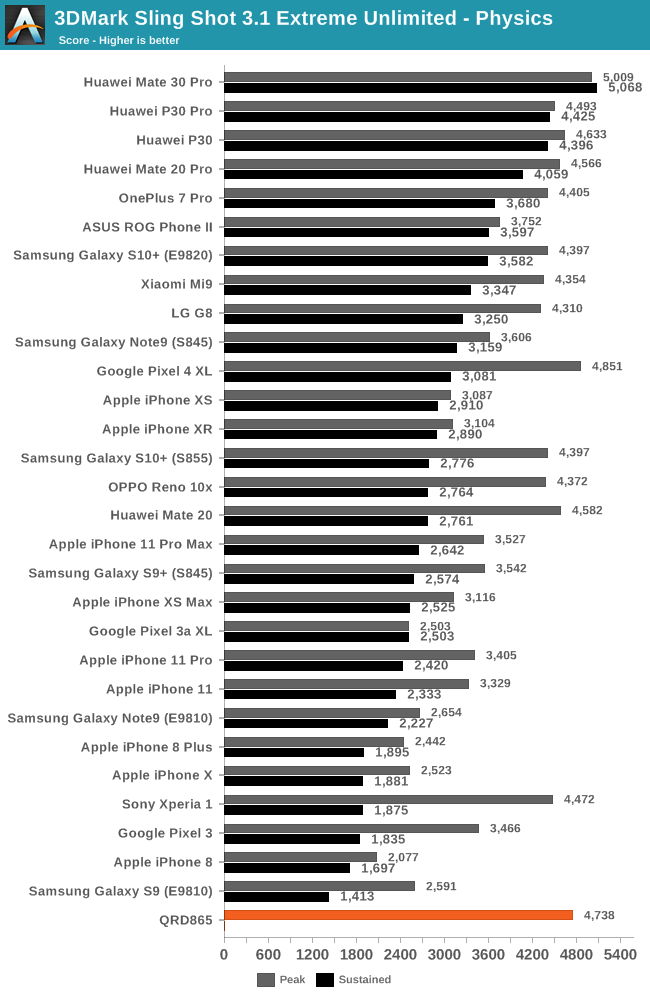
The 3DMark Physics tests is a CPU-bound benchmark within a GPU power constrained scenario. The QRD865 here oddly enough doesn’t showcase major improvements compared to its predecessor, in some cases actually being slightly slower than the Pixel 4 XL and also falling behind the Kirin 990 powered Mate 30 Pro even though the new Snapdragon has a microarchitectural advantage. It seems the A77 does very little in terms of improving the bottlenecks of this test.
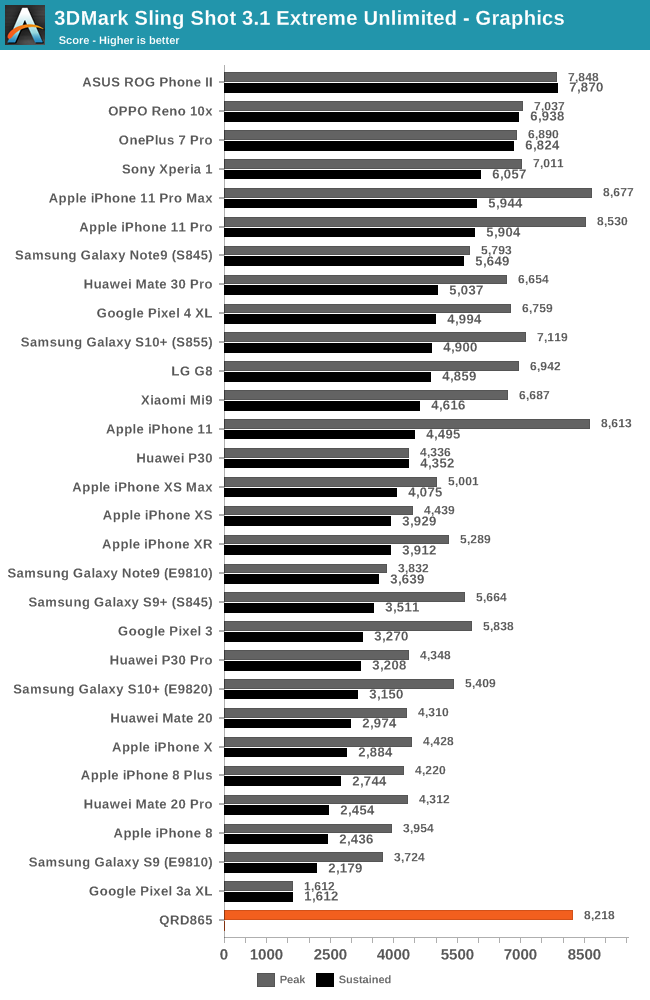
In the 3DMark Graphics test, the QRD865 results are more in line with what we expect of the GPU. Depending on which S855 you compare to, we’re seeing 15-22% improvements in the peak performance.
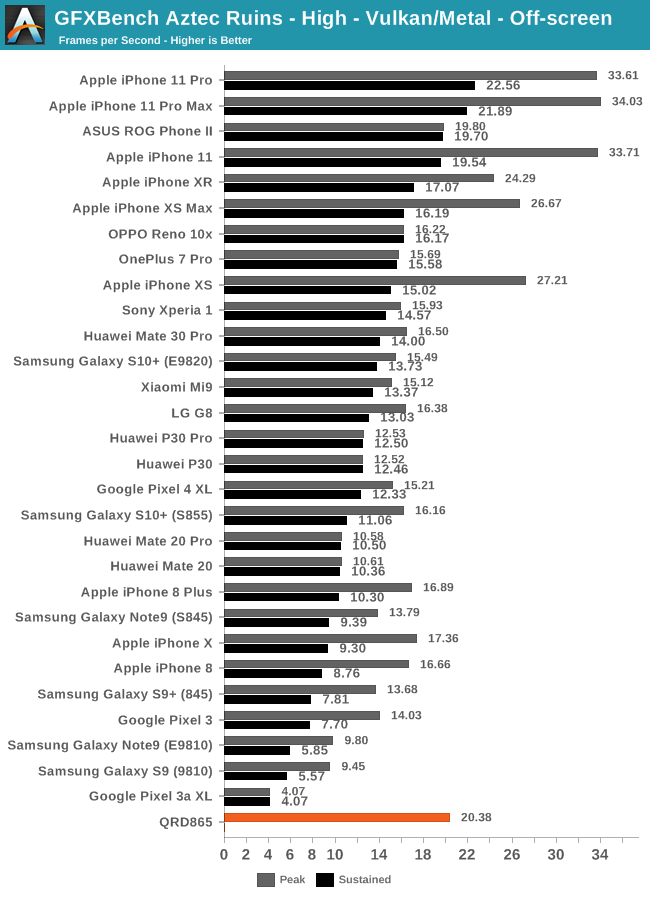
In the GFXBench Aztec High benchmark, the improvement over the Snapdragon 855 is roughly 26%. There’s one apparent issue here when looking at the chart rankings; although there’s an improvement in the peak performance, the end result is that the QRD865 still isn’t able to reach the sustained performance of Apple’s latest A13 phones.
| GFXBench Aztec High Offscreen Power Efficiency (System Active Power) |
||||
| Mfc. Process | FPS | Avg. Power (W) |
Perf/W Efficiency |
|
| iPhone 11 Pro (A13) Warm | N7P | 26.14 | 3.83 | 6.82 fps/W |
| iPhone 11 Pro (A13) Cold / Peak | N7P | 34.00 | 6.21 | 5.47 fps/W |
| iPhone XS (A12) Warm | N7 | 19.32 | 3.81 | 5.07 fps/W |
| iPhone XS (A12) Cold / Peak | N7 | 26.59 | 5.56 | 4.78 fps/W |
| QRD865 (Snapdragon 865) | N7P | 20.38 | 4.58 | 4.44 fps/W |
| Mate 30 Pro (Kirin 990 4G) | N7 | 16.50 | 3.96 | 4.16 fps/W |
| Galaxy 10+ (Snapdragon 855) | N7 | 16.17 | 4.69 | 3.44 fps/W |
| Galaxy 10+ (Exynos 9820) | 8LPP | 15.59 | 4.80 | 3.24 fps/W |
Looking at the estimated power draw of the phone, it indeed does look like Qualcomm has been able to sustain the same power levels as the S855, but the improvements in performance and efficiency here aren’t enough to catch up to either the A12 or A13, with Apple being both ahead in terms of performance, power and efficiency.
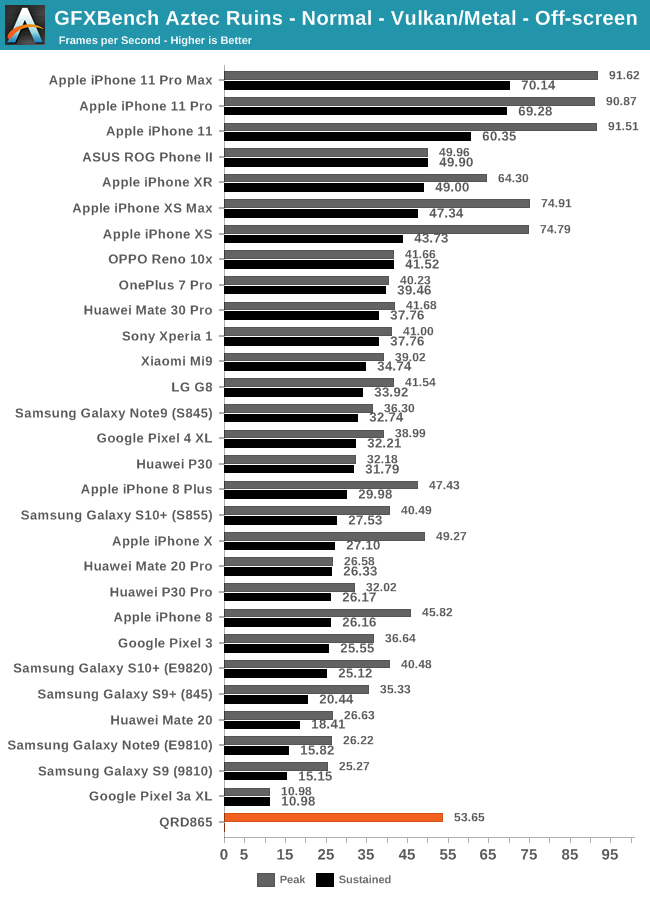
| GFXBench Aztec Normal Offscreen Power Efficiency (System Active Power) |
||||
| Mfc. Process | FPS | Avg. Power (W) |
Perf/W Efficiency |
|
| iPhone 11 Pro (A13) Warm | N7P | 73.27 | 4.07 | 18.00 fps/W |
| iPhone 11 Pro (A13) Cold / Peak | N7P | 91.62 | 6.08 | 15.06 fps/W |
| iPhone XS (A12) Warm | N7 | 55.70 | 3.88 | 14.35 fps/W |
| iPhone XS (A12) Cold / Peak | N7 | 76.00 | 5.59 | 13.59 fps/W |
| QRD865 (Snapdragon 865) | N7P | 53.65 | 4.65 | 11.53 fps/W |
| Mate 30 Pro (Kirin 990 4G) | N7 | 41.68 | 4.01 | 10.39 fps/W |
| Galaxy 10+ (Snapdragon 855) | N7 | 40.63 | 4.14 | 9.81 fps/W |
| Galaxy 10+ (Exynos 9820) | 8LPP | 40.18 | 4.62 | 8.69 fps/W |
We’re seeing a similar scenario in the Normal variant of the Aztec test. Although the performance improvements here do match the promised figures, it’s not enough to catch up to Apple’s two latest SoC generations.
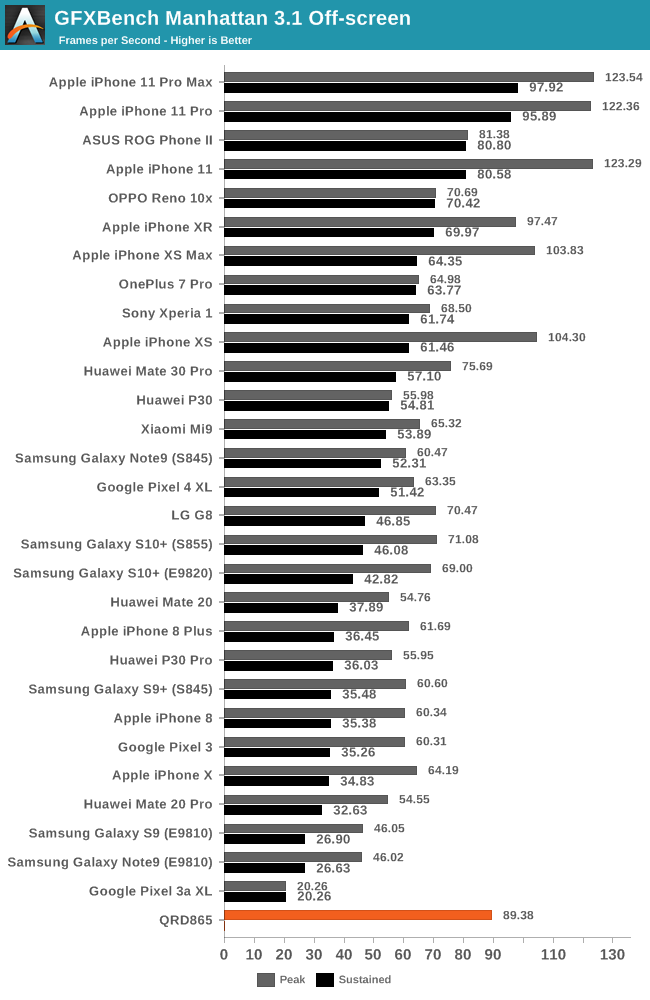
| GFXBench Manhattan 3.1 Offscreen Power Efficiency (System Active Power) |
||||
| Mfc. Process | FPS | Avg. Power (W) |
Perf/W Efficiency |
|
| iPhone 11 Pro (A13) Warm | N7P | 100.58 | 4.21 | 23.89 fps/W |
| iPhone 11 Pro (A13) Cold / Peak | N7P | 123.54 | 6.04 | 20.45 fps/W |
| iPhone XS (A12) Warm | N7 | 76.51 | 3.79 | 20.18 fps/W |
| iPhone XS (A12) Cold / Peak | N7 | 103.83 | 5.98 | 17.36 fps/W |
| QRD865 (Snapdragon 865) | N7P | 89.38 | 5.17 | 17.28 fps/W |
| Mate 30 Pro (Kirin 990 4G) | N7 | 75.69 | 5.04 | 15.01 fps/W |
| Galaxy 10+ (Snapdragon 855) | N7 | 70.67 | 4.88 | 14.46 fps/W |
| Galaxy 10+ (Exynos 9820) | 8LPP | 68.87 | 5.10 | 13.48 fps/W |
| Galaxy S9+ (Snapdragon 845) | 10LPP | 61.16 | 5.01 | 11.99 fps/W |
| Mate 20 Pro (Kirin 980) | N7 | 54.54 | 4.57 | 11.93 fps/W |
| Galaxy S9 (Exynos 9810) | 10LPP | 46.04 | 4.08 | 11.28 fps/W |
| Galaxy S8 (Snapdragon 835) | 10LPE | 38.90 | 3.79 | 10.26 fps/W |
| Galaxy S8 (Exynos 8895) | 10LPE | 42.49 | 7.35 | 5.78 fps/W |
Even on the more traditional tests such as Manhattan 3.1, although again the Adreno 650 is able to showcase good improvements this generation, it seems that Qualcomm didn’t aim quite high enough.
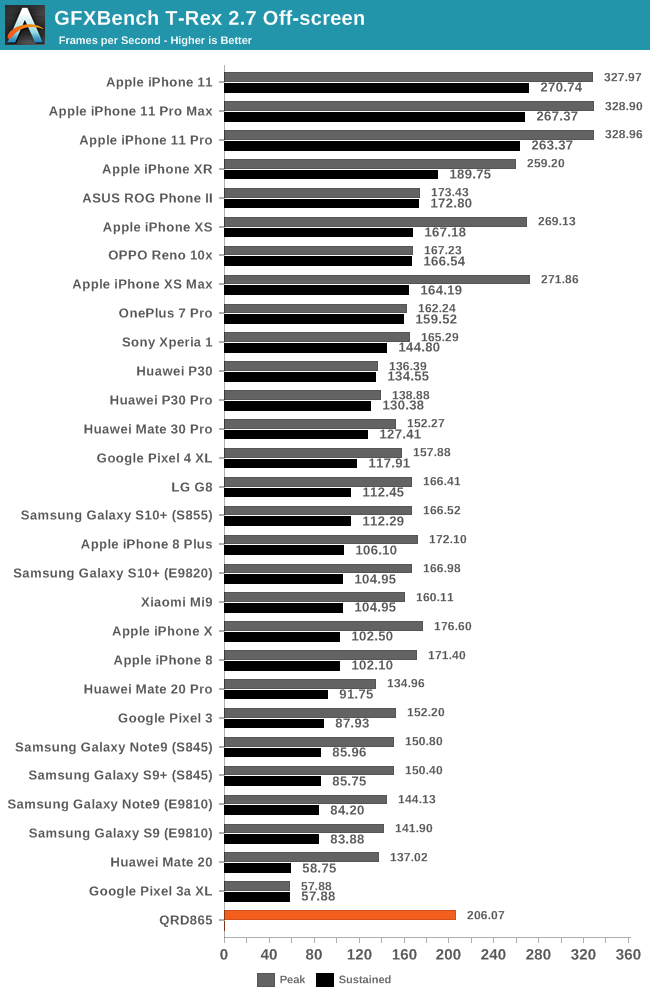
| GFXBench T-Rex Offscreen Power Efficiency (System Active Power) |
||||
| Mfc. Process | FPS | Avg. Power (W) |
Perf/W Efficiency |
|
| iPhone 11 Pro (A13) Warm | N7P | 289.03 | 4.78 | 60.46 fps/W |
| iPhone 11 Pro (A13) Cold / Peak | N7P | 328.90 | 5.93 | 55.46 fps/W |
| iPhone XS (A12) Warm | N7 | 197.80 | 3.95 | 50.07 fps/W |
| iPhone XS (A12) Cold / Peak | N7 | 271.86 | 6.10 | 44.56 fps/W |
| QRD865 (Snapdragon 865) | N7P | 206.07 | 4.70 | 43.84 fps/W |
| Galaxy 10+ (Snapdragon 855) | N7 | 167.16 | 4.10 | 40.70 fps/W |
| Mate 30 Pro (Kirin 990 4G) | N7 | 152.27 | 4.34 | 35.08 fps/W |
| Galaxy S9+ (Snapdragon 845) | 10LPP | 150.40 | 4.42 | 34.00 fps/W |
| Galaxy 10+ (Exynos 9820) | 8LPP | 166.00 | 4.96 | 33.40fps/W |
| Galaxy S9 (Exynos 9810) | 10LPP | 141.91 | 4.34 | 32.67 fps/W |
| Galaxy S8 (Snapdragon 835) | 10LPE | 108.20 | 3.45 | 31.31 fps/W |
| Mate 20 Pro (Kirin 980) | N7 | 135.75 | 4.64 | 29.25 fps/W |
| Galaxy S8 (Exynos 8895) | 10LPE | 121.00 | 5.86 | 20.65 fps/W |
Lastly, the T-Rex benchmark which is the least compute heavy workload tested here, and mostly is bottlenecked by texture and fillrate throughput, sees a 23% increase for the Snapdragon 865.
Overall GPU Conclusion – Good Improvements – Competitively Not Enough
Overall, we were able to verify the Snapdragon 865’s performance improvements and Qualcomm’s 25% claims seem to be largely accurate. The issue is that this doesn’t seem to be enough to keep up with the large improvements that Apple has been able to showcase over the last two generations.
During the chipset’s launch, Qualcomm was eager to mention that their product is able to showcase better long-term sustained performance than a competitor which “throttles within minutes”. While we don’t have confirmation as to whom exactly they were referring to, the data and narrative here only matches Apple’s device behaviour. Whilst we weren’t able to test the sustained performance of the QRD865 today, it unfortunately doesn’t really matter for Qualcomm as the Snapdragon 865 and Adreno 650’s peak performance falls in at a lower level than Apple’s A13 sustained performance.
Apple isn’t the only one Qualcomm has to worry about; the 25% performance increases this generation are within reach of Arm’s Mali-G77. In theory, Samsung’s Exynos 990 should be able to catch up with the Snapdragon 865. Qualcomm had been regarded as the mobile GPU leader over the last few years, but it’s clear that development has slowed down quite a lot recently, and the Adreno family has lost its crown.










178 Comments
View All Comments
UglyFrank - Monday, December 16, 2019 - link
I imagine the Tab S7 will have this.Meanwhile the iPad Pro 2020 will most likely have more than double the GPU power.
Kishoreshack - Monday, December 16, 2019 - link
That's not how it works broUglyFrank - Monday, December 16, 2019 - link
It is. The A12X has more than double the S855's GPU performance and we can expect ~ 20% increase in GPU performance (A12X to A13X) as the A12 to A13 had a similar increase.generalako - Monday, December 16, 2019 - link
Ok, but then again the SD875 (or whatever it will be called) is expected to be on a new architecture after 3 generation, which generally means 50%+ jump just there. With the transition over to 5nm, you can expect even more performance from that. That would, after all, be the most fair comparison to the A14 (or A14X) on 5nm later this year, due to process node comparisons. Same with CPUs (don't forget, the A77 in the SD865 was released in the summer before by ARM, and even presented in the SD865 in December).close - Tuesday, December 17, 2019 - link
Over the past few years Apple has been doing a consistently better job than Qualcomm regardless of process node. Probably they can afford to since they are in full control of the whole technology stack, including the software which means they can squeeze additional performance and efficiency like that. But this doesn't change the fact that year after year A-chips are better than their counterparts.tuxRoller - Wednesday, December 18, 2019 - link
I'm not sure that apple is much, if at all, more optimized than the Android bsps. If you're aware of proof to the contrary I'd be interested in reading it.michael2k - Wednesday, December 18, 2019 - link
It doesn’t mean optimized the way you envision it. It means more tailored to the design, since Apple has a fixed number of systems it has to support. There are three ways to see it: how many years does Apple push iOS updates? That is a function of performance as well, as as the OS.Another way to see it is knowing that Apple ships iPhones with much less RAM, meaning their OS and apps have to be designed to use less RAM too.
Likewise their iPhone usually ships with smaller batteries; by designing the OS, SoC, and RAM synergistically they can use a smaller battery too. RAM happens to use energy even when idle, so less RAM does translate to lower energy usage.
michael2k - Tuesday, December 17, 2019 - link
Yeah, but anything Qualcomm does to boost performance, Apple will be doing too.The 865 is going to compete with the A14 in 2020, and the 875 will compete with the A15 in 2021. So if we expect the A14 to boost perf by 15% and the A14X to boost perf by 40%, and the A15 to boost perf again by 10% and A15X to boost perf again by 25%, you'll see:
855 = 1.00
865 = 1.25
875 = 1.50
A13 = 1
A13X = 1.4
A14 = 1.15
A14X = 1.96
A15 = 1.26
A15X = 2.45
Technically Qualcomm has more room to improve when you compare transistor budgets: the A13 is approximately 8.5b transistors, the A12 7b transistors.
In comparison, the 855 only had 6b transistors, per Qualcomm itself:
https://www.qualcomm.com/media/documents/files/sna...
id4andrei - Tuesday, December 17, 2019 - link
The 865 competes with A13 not with the future A14. Apple sets the cadence in the SoC space and have done so since breaking rank with sheer performance and transition to a 64bit arch.generalako - Tuesday, December 17, 2019 - link
This is just misrepresentative. The past two generations ARM's architecture has been closing the gap to Apple. It closed the gap by around 30% in IPC with A76, and doing so by around 15% in IPC with A77 (A77 had 27% IPC gain vs. A13's 12% IPC gain). The gap has been getting smaller, and hopefully it will continue. But the fact is still that it's closing for the performance cores.Also, you're comparisons are way off. The SD855 was comparable to the A12, just as the SD865 is to the A13, and so on and so forth. This with process node and the actual release date of the Cortex Core in mind.